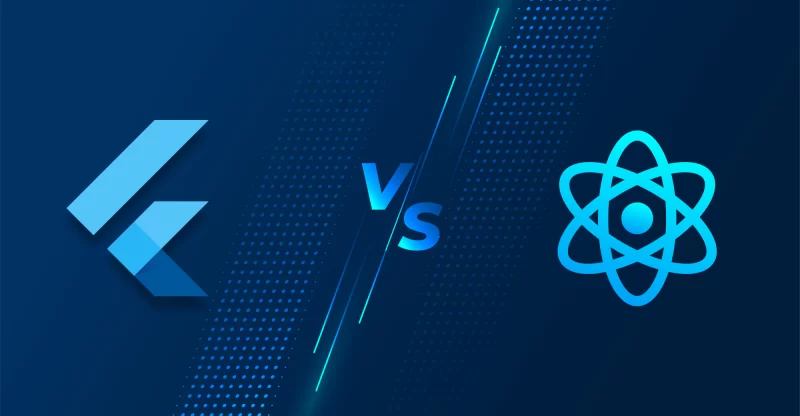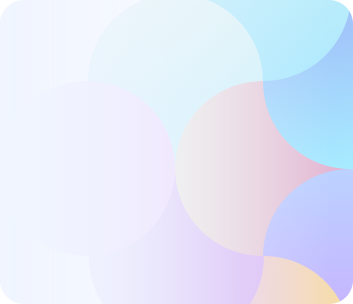Flutter vs React Native: Which One is The Best Framework in 2024?

Planning to build a cross-platform chat app but unsure which tech framework to use? Worry not, we’ve penned down the differences between React Native and Flutter from the developer’s lens to help you in your app development process.
Cross-platform mobile apps saw a significant rise in the past decade when Google and Facebook launched Flutter and React Native cross-platform app development frameworks. And since then these two giants have helped many developers build the right project at the right time without spending hefty prices.
So in the Flutter vs React Native blog below, we will see the comparison between the two and their technical details that would help developers decide on which framework to use for their upcoming projects.
Before that,
Table of Contents
What is Cross-platform Mobile App Development?
Cross-platform mobile app development in a nutshell means writing code once and deploying them across different platforms like Android, iOS, and the web, thereby minimizing the cost and time behind its development.
Now, let us look at their similarities
React Native vs Flutter: What’s Similar in Them?
When asked about their similarities, the first thing that strikes our mind is that both are open-source platforms. And the second thing is that both Flutter and React Native use the “Hot Reload” feature.
The Hot Reload feature lets mobile app developers see the changes they made without having to reload the application.
Pro Idea: Apps like Google Ads, Xianyu, and Hamilton were built using Flutter. React Native framework was used to code Instagram, FB, and Pinterest.
Now that we have seen the similarities between the two cross-platform mobile app development frameworks, let us now see which outweighs the other.
React Native or Flutter – Which is Better?
As we learn that these two frameworks are highly accepted by developers all around for their performance, quality, and cost-effectiveness options, one differs from the other based on the app requirements and criteria like:
- Time-to-dispatch: When comes to time-to-market, Flutter assures for a faster development time than React Native.
- UI Designs: Developers opt for Flutter as it gives identical UI codes for iOS and Android platforms, to React Native.
- Reuse of Codes: Because of plenty of widget options available in Flutter, code reusability is highly efficient under this framework.
- Wider Audience: Though cross-platform apps have an extended reach amongst coders, Flutter is dominating the market.
With the criteria in hand, you may opt for the Flutter framework if you app requirements falls under these categories
- You are given a shorter time to market,
- Need to write code soon
- Need to customize UI to make it more friendly to use
- If you are provided with a lower budget
- And if your app needs hi-fi functionality.
Similarly, choose React Native when your app requirements are these:
- Your app development is not restricted by time or budget
- There is a requirement to create a shared API
- There is a need to develop lightweight apps
- The app’s UI must be quite appealing
So, based on your app requirement, you can choose whether to download React Native or Flutter. But, down the time, will the two frameworks remain even in the next decade or will it be short lived? Let’s find out next.
React Native vs Flutter: Which Has the Future?
In the mobile app development landscape, the battle between Flutter and React Native has been fierce since the former’s inception.
However, with Flutter’s merits and functionalities, cutting-edge capabilities, coding-friendliness, and novel improvements, this particular framework seems a bit more promising than React Native.
And now, the latest version of Flutter 2.10 has proved to offer stable support for Windows too with many big brands using this version because of features like
- Good ecosystem
- Faster performance and improved tracing characteristic
- Dart virtual machine
- Reduced latency and
- Improved memory footprint

When we looked at how beneficial Flutter turned out to be, React Native has also brought in numerous enhancements and features like
- Detailed documentation
- Support tools and reliable APIs
- Enhanced GitHub repository
- Fast refresh rates
- Supports CocoaPods
- Renders Windows look

So, it is cut and clear which framework has the future post learning about the differences and pros. Let us delve a little deeper into both frameworks to gain insights about them.
Head-on Comparison Between Flutter vs React Native
Throughout the blog, we focused on which framework (React Native vs Flutter) will emerge amongst developers as the superior one. But, whenever we talk about them the only difference that comes to our mind is,
Flutter – an open-source framework that uses a single codebase to build cross-platform apps.
React Native – an open-source framework to build native apps that run on cross-platforms like Android and iOS.
But let me tell you, buddies, these ain’t all, because there is a plenitude of distinctiveness that comes as a Jack-in-the-box to all. So below, we have a head-on comparison between the two frameworks for easy understanding.
| Functionalities | Flutter | React Native |
|---|---|---|
| Compatibility | Android 4.1 and iOS 8 | Android 4.1 and iOS 10 |
| Plugins | Google’s Geolocation and Mapping | Fetch, Maps, Firebase, and Navigation |
| Programming Language | Dart | Javascript |
| Compilation | Compiles Dart to Native code | Doesn’t compile JS to any native codes like Java, Swift or C |
| Designed By | ||
| Prime Architecture | Bloc | Flux and Redux |
| Library | Small and non-inclusive | A larger library |
| Ease-of-use | Need a learning curve as it is Dart | Easy to learn as it is based on Javascript and React |
| Components | Needs manual configuration of components | Automatically components gets adapted |
Hope, this distinction between the two would have given you an idea on which framework would work best for your upcoming project. But, if you are still worried about its technical details, look out at our next section.
Flutter vs React Native: Which to Choose for App Development?
We got hold of the fact till now by reading the article that both Flutter and React Native are widely used frameworks for building cross-platform apps from a single codebase. Here, we will detail the strengths and demerits of each that may apply to your project:
1. Development Environment: Flutter needs the use of its integrated development environment while React Native comes compatible with any IDE.
2. App’s Front-end Design: Web developers usually prefer React Native because of its CSS components that make the front look appealing.
3. Performance of App: Even if you have built apps with heavy graphics, Flutter’s Dart never subsides the app’s performance.
4. Coding Language: React Native uses Javascript, which is quite commonly used today. But Flutter’s Dart needs learning.
5. UI Look: Using the Flutter framework gives a consistent UI look throughout the pages whereas, React Native lifts a near-to-native look.
How MirrorFly Helps With Flutter and React Native?
We hope that this article comes as a great start to learning about the clear analysis of Flutter vs React Native app development. Now we will also brief you on how MirrorFly can help you with both frameworks thus simplifying your app development process.
MirrorFly provides customizable video, voice, and chat APIs and UI kits for both React Native and Flutter frameworks so that app developers like you can easily integrate all required call and chat features into your apps.
Further, its self-hosted solution gives you the flexibility to host apps on your servers, take complete ownership of MirrorFly’s Flutter and React Native SDKs, and brand your app with your identity elements.
So what do you say? Ready to try?
Get Started with MirrorFly’s Secure Chat Features Today!
Drive 1+ billions of conversations on your apps with highly secure 250+ real-time Communication Features.
Contact Sales200+ Happy Clients
Topic-based Chat
Multi-tenancy Support

Related Articles
- Top 10 React Native Component Libraries in 2024
- Build React Native Chat App Using MirrorFly SDK
- Top 7 React Native Chat APIs And SDK Providers In 2024
- How To Build A React Native Video Chat App in 2024?
- Simple Steps To Create a React Video Chat App